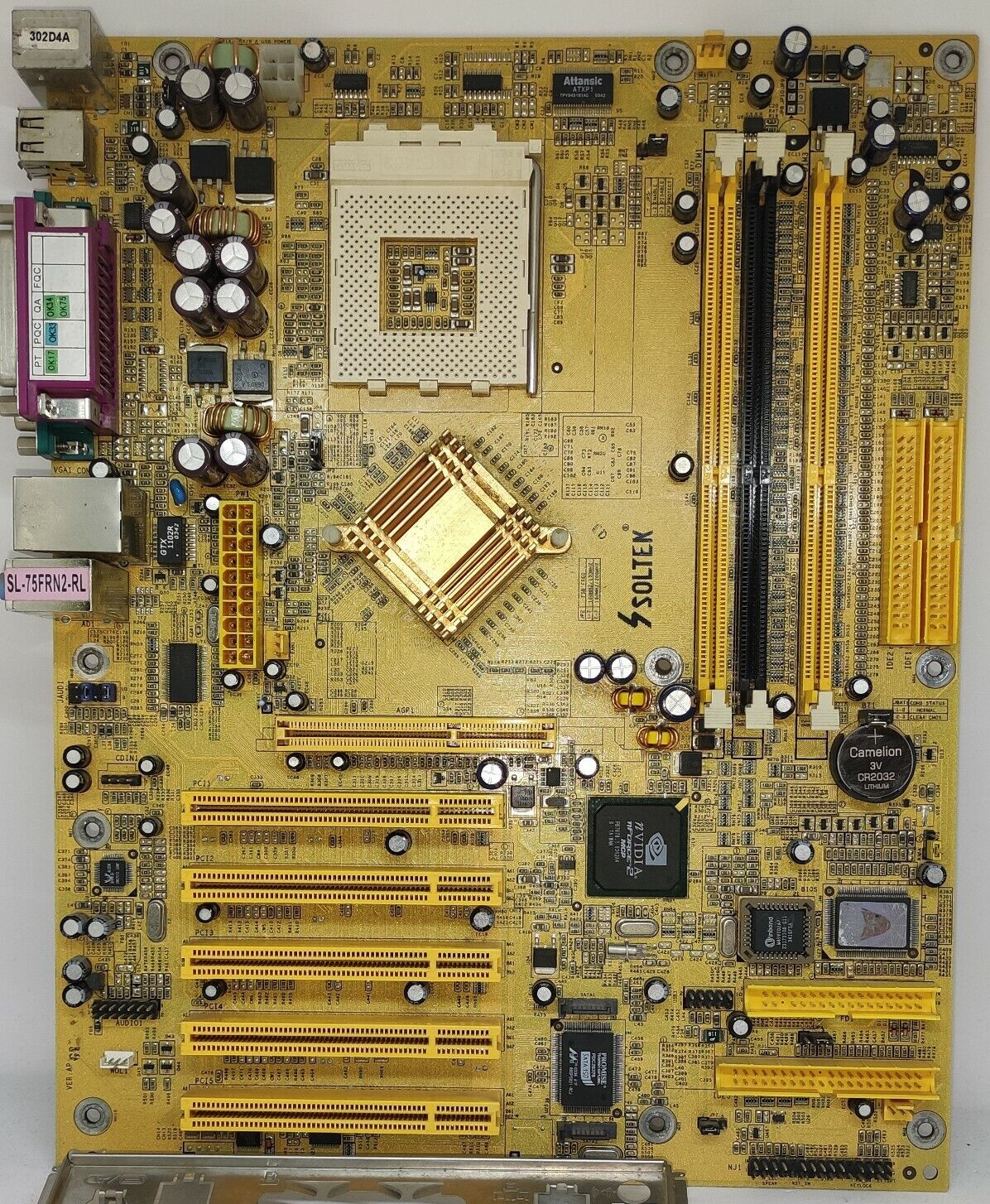Reply 60 of 81, by gamefan_851
bloodem wrote on 2023-07-26, 07:03:The Athlon XP 2800+ (which is most likely a Barton, though it could also be a "Thoroughbred"), is a VERY powerful CPU. In fact, […]
gamefan_851 wrote on 2023-07-26, 06:11:Would you say that the Athlon XP 2800+ is decent cpu?
The Athlon XP 2800+ (which is most likely a Barton, though it could also be a "Thoroughbred"), is a VERY powerful CPU.
In fact, it might be a bit too powerful, which is why I recommended a slower Athlon XP.
The issue with the majority of Socket A motherboards is the fact that they draw most of their power from the PSU's 5V rail. An Athlon XP 2800+ will be very power hungry and most modern PSUs won't work reliably (or won't work at all), since they have very weak 5V & 3.3V rails. Phil has a video where he demonstrates the behavior you can expect depending on how hungry the CPU and video card are: https://www.youtube.com/watch?v=efK7mw8eYiE
Of course, if you can find a good quality PSU that offers at least 25 amps on the 5V & 3.3V rails, then the Barton 2800+ will be a beast.Here are my notes from a few years ago, when I tested a Barton 2600+:
MOTHERBOARD: Asus A7V880
RAM: Geil 512MB DDR400
GPU: MSI nVIDIA GeForce 4 Ti 4400 / nVIDIA driver 30.82
SOUND CARD: Yamaha YMF724F-V1. AMD Athlon XP "Barton" 2600+ STOCK @ 1916 MHz (FSB 166MHz x 11.5)
3DMARK2001SE - 10714
3DMARK2000 - 14672
3DMARK99 - 16149GLQuake 640 x 480 x 16 ---> 763.8 FPS
GLQuake 1024 x 768 x 32 ---> 413.3 FPS
GLQuake 1280 x 960 x 32 ---> 290.0 FPS
Quake 2 SOFTWARE 640 x 480 x 16 ---> FPS (sound: High & Max Performance)
Quake 2 640 x 480 x 16 ---> 491.1 FPS (sound: High & Max Performance)
Quake 2 1024 x 768 x 32 ---> 450.6 FPS (sound: High & Max Performance)
Quake 2 1024 x 768 x 32 ---> 359.8 FPS (sound: High & Max Performance)
Quake 3 640 x 480 x 16 ---> 204.6 FPS
Quake 3 1024 x 768 x 32 ---> 201.5 FPS
Quake 3 1280 x 1024 x 32 ---> 181.9 FPS
Expendable 640 x 480 x 16 ---> AVG 172.04 / High: 232 / Low: 123 (no sound)
Expendable 640 x 480 x 16 ---> AVG 164.51 / High: 219 / Low: 115 (with sound -> EAX)2. AMD Athlon XP "Barton" 2600+ OVERCLOCKED @ 2300 MHz (FSB 200MHz x 11.5)
3DMARK2001SE - 11525
3DMARK2000 - 16115
3DMARK99 - 18492GLQuake 640 x 480 x 16 ---> 838.0 FPS
GLQuake 1024 x 768 x 32 ---> 413.4 FPS
GLQuake 1280 x 960 x 32 ---> 289.9 FPS
Quake 2 SOFTWARE 640 x 480 x 16 ---> 101.8 FPS (sound: High & Max Performance)
Quake 2 640 x 480 x 16 ---> 563.8 FPS (sound: High & Max Performance)
Quake 2 1024 x 768 x 32 ---> 488.0 FPS (sound: High & Max Performance)
Quake 2 1600 x 1200 x 32 ---> 363.6 FPS (sound: High & Max Performance)
Quake 3 640 x 480 x 16 ---> 244.9 FPS
Quake 3 1024 x 768 x 32 ---> 235.2 FPS
Quake 3 1280 x 1024 x 32 ---> 199.8 FPS
Quake 3 1600 x 1200 x 32 ---> 150.1 FPS
Expendable 640 x 480 x 16 ---> AVG 204.16 / High: 267 / Low: 146 (no sound)
Expendable 640 x 480 x 16 ---> AVG 196.56 / High: 259 / Low: 140 (with sound -> EAX)And, just for comparison, here are some similar benchmarks from one of my Tualatin builds:
MOTHERBOARD: Abit ST6
CPU: Pentum 3-S Tualatin 1.4 GHz
RAM: 512MB PC133
GPU: Gainward nVIDIA GeForce 4 Ti 4200 / nVIDIA driver 30.82
SOUND CARD Creative Sound Blaster Live 5.1 SB01003DMark99Max: 11065 3D marks / 21757 CPU marks
3DMark2000: 10129 3D marks / 697 CPU marks
3DMark2001: 8112 3D marksGLQuake 640 x 480 x 16: 564.9 FPS
GLQuake 1024 x 768 x 32: 333.8 FPS
GLQuake 1024 x 768 x 32: 219.6 FPSQuake 2 640 x 480 x 16: 334.8 FPS
Quake 2 1024 x 768 x 32: 321.1 FPS
Quake 2 1280 x 960 x 32: 270.6 FPSQuake 3 640 x 480 x 16: 134.7 FPS
Quake 3 1024 x 768 x 32: 133.2 FPS
Quake 3 1280 x 1024 x 32: 124.6 FPSExpendable 640 x 480 x 16: AVG 103.92 FPS / HIGH 151 FPS / LOW 72 FPS (NO SOUND)
Expendable 640 x 480 x 16: AVG 101.56 FPS / HIGH 142 FPS / LOW 67 FPS (WITH SOUND - EAX)
Expendable 1024 x 768 x 32: AVG 100.15 FPS / HIGH 149 FPS / LOW 67 FPS (WITH SOUND - EAX)
Expendable 1280 x 1024 x 32: AVG 96.52 FPS / HIGH 135 FPS / LOW 66 FPS (WITH SOUND - EAX)Unreal Tournament 640 x 480 x 16: AVG 51.65 FPS / HIGH 85.84 FPS / 31.69 FPS
Unreal Tournament 1024 x 768 x 32: AVG 49.27 FPS / HIGH 74.53 FPS / 29.45 FPS
Unreal Tournament 1280 x 1024 x 32: AVG 48.49 FPS / HIGH 73.86 FPS / 29.14 FPS
Thanks a lot for posting the bechmarks. That was really interesting to read.
it makes that the athlon xp 2800+ might be bit too powerful for the my set up.
Looking for a slower athlon xp might be a good idea.
Is there certain slower Athlon Xp you would recommend?
